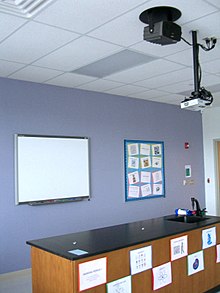SMARTBoard

A SMART Board in Union City High School in New Jersey equipped with an overhead projector
|
|
| Manufacturer | Smart Technologies |
|---|---|
| Introduced | 1991 |
| Type | Interactive whiteboard |
| Connection | computer and DVD |
| Ports | USB cable, VGA cable |
| Weight | 90 lbs. |
The Smart Board (stylized as "SMART Board") is a line of interactive whiteboards produced by the Calgary, Alberta-based company SMART Technologies.
David Martin began SMART company in 1987 as the Canadian distributor for a U.S. projector company. The revenue it collected from the projectors was put into research and development on the SMART board interactive whiteboard, which was the first interactive whiteboard to provide touch control of computer applications and the ability to write over standard Microsoft Windows applications.
The SMART Board is an interactive whiteboard that uses touch detection for user input (for example scrolling and right mouse-click) in the same way as normal PC input devices. The Smart Board 800 series interactive whiteboard introduced a 'flick and scroll' feature.
In December 2010, Smart company introduced the lower-cost Smart Board 400 series interactive whiteboard.
The SMART Board interactive whiteboard operates as part of a system that includes the interactive whiteboard, a computer, a projector and whiteboarding software - either Smart Notebook collaborative learning software for education, or SMART Meeting Pro software for business. The components are connected wirelessly or via USB or serial cables. A projector connected to the computer displays the desktop image on the interactive whiteboard. The whiteboard accepts touch input from a finger, pen or other solid object. Older models rely on an external projector to work but certain projector-based models have an integrated projector built in to the top of the Board. The newest models can display UHD graphics and are self-contained flat panels which do not need a projector. Some of these self-contained flat panel models are also equipped with a motion sensor on the bottom-right corner of the Board. This sensor can save power by putting the SMART Board to sleep when no movement is detected. The SMART Board will then automatically wake itself up when movement is detected, such as when a teacher, pupil or employee enters the room.
Most models of SMART Board include a pen tray on the front of the interactive whiteboard that holds two to four plastic pen tools and SOMETIMES an eraser. The pen tools have neither electronic components nor ink - the technology is in the pen tray. When a pen tool is removed from its slot in the tray, a sensor recognizes its absence. In older models this was an optical sensor but newer, self-contained flat-panel models use a magnetic sensor which also works to keep the pen attached to the board when not in use. The Smart Board software processes the next contact with the interactive whiteboard surface as a pen action from the pen tool that resides in the corresponding slot. Older models of the Smart Board interactive whiteboard features slots for black, blue, red and green pen tools, although a control panel can be used to change the color of the digital ink or change the pen tools to colored highlighters.
...
Wikipedia
